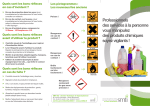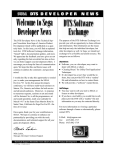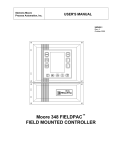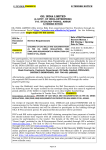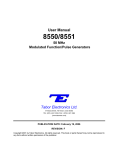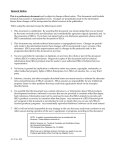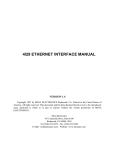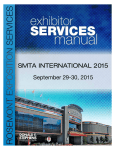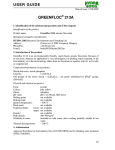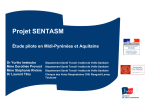Download Sample Game Program User`s Manual
Transcript
When using this document, keep the following in mind:
nti
al
General Notice
1. This document is confidential. By accepting this document you acknowledge that you are bound
by the terms set forth in the non-disclosure and confidentiality agreement signed separately and /in
the possession of SEGA. If you have not signed such a non-disclosure agreement, please contact
SEGA immediately and return this document to SEGA.
de
2. This document may include technical inaccuracies or typographical errors. Changes are periodically made to the information herein; these changes will be incorporated in new versions of the
document. SEGA may make improvements and/or changes in the product(s) and/or the
program(s) described in this document at any time.
nfi
3. No one is permitted to reproduce or duplicate, in any form, the whole or part of this document
without SEGA’S written permission. Request for copies of this document and for technical
information about SEGA products must be made to your authorized SEGA Technical Services
representative.
4. No license is granted by implication or otherwise under any patents, copyrights, trademarks, or
other intellectual property rights of SEGA Enterprises, Ltd., SEGA of America, Inc., or any third
party.
Co
5. Software, circuitry, and other examples described herein are meant merely to indicate the characteristics and performance of SEGA’s products. SEGA assumes no responsibility for any intellectual
property claims or other problems that may result from applications based on the examples
describe herein.
GA
6. It is possible that this document may contain reference to, or information about, SEGA products
(development hardware/software) or services that are not provided in countries other than Japan.
Such references/information must not be construed to mean that SEGA intends to provide such
SEGA products or services in countries other than Japan. Any reference of a SEGA licensed product/program in this document is not intended to state or simply that you can use only SEGA’s
licensed products/programs. Any functionally equivalent hardware/software can be used instead.
7. SEGA will not be held responsible for any damage to the user that may result from accidents or any
other reasons during operation of the user’s equipment, or programs according to this document.
SE
NOTE: A reader's comment/correction form is provided with this
document. Please address comments to :
SEGA of America, Inc., Developer Technical Support (att. Evelyn Merritt)
150 Shoreline Drive, Redwood City, CA 94065
SEGA may use or distribute whatever information you supply in any way
it believes appropriate without incurring any obligation to you.
(11/2/94- 002)
SE
GA
Co
nfi
de
nti
al
TM
Sample Game
Program
User's Manual
Doc. # ST-159-R1-092994
© 1994-95 SEGA. All Rights Reserved.
nti
al
READER CORRECTION/COMMENT SHEET
Keep us updated!
If you should come across any incorrect or outdated information while reading through the attached
document, or come up with any questions or comments, please let us know so that we can make the
required changes in subsequent revisions. Simply fill out all information below and return this form to
the Developer Technical Support Manager at the address below. Please make more copies of this form if
more space is needed. Thank you.
General Information:
Your Name
Phone
ST-159-R1-092994
Document name
Sample Game Program User's Manual
de
Document number
Date
Corrections:
Correction
nfi
pg. #
GA
Co
Chpt.
SE
Questions/comments:
Fax:
Where to send your corrections:
(415) 802-1717
Attn: Evelyn Merritt,
Developer Technical Support
Mail:
SEGA OF AMERICA
Attn: Evelyn Merritt,
Developer Technical Support
150 Shoreline Dr.
Redwood City, CA 94065
nti
al
Sample Game Program
User’s Manual
Introduction ............................................................... 3
Overview ................................................................... 4
Game Sequence ....................................................... 5
Basic Function Program ......................................... 10
Action Control ......................................................... 12
Directory Structure, File Name,
Function Name, Variable Name.............................. 18
7. Compile/Execute Procedure ................................... 19
8. SIMM/VCD Compatibility ........................................ 20
SE
GA
Co
nfi
de
1.
2
3.
4.
5.
6.
Sample Game Program User's Manual
1
SE
GA
Co
nfi
de
nti
al
(This page is blank in the original Japanese document.)
2
1. Introduction
nti
al
To develop a game, responsible people are needed for planning, programming,
designing, sound development, etc. The following three items are among the first
things a programmer must keep in mind:
1) Characteristics of the game machine hardware.
2) Development environment of the game machine.
3) Game programming basics
de
This manual concentrates on explaining “(3) Game Programming Basics,” using
sample programs. To aid in understanding this manual, it would be beneficial to
play several games on a MEGA Drive or other game machine. Also, it would help to
read the coding regulations from the sample program list.
SE
GA
Co
nfi
The program must be changed since part of it does not satisfy the game creation
standard. For instance, the program performs input of the controller by the through
mode, but this should be changed because the SMPC command must be used.
Sample Game Program User's Manual
3
2. Overview
nti
al
This sample program is located in the SEGAGAME directory. The sample program
structure is shown in Figure 1; however, this manual breaks it up into the following
classifications.
Game Sequence
These are display, Sega logo display, title display and program select in Figure 1.
These are common for most games.
de
Basic Function Program
The basic function programs are the sprite samples and scroll sample shown in
Figure 1.
SE
GA
Co
nfi
Action Control
This is the 2D shooting game and a game demo is shown in Figure 1. The manual
explains how to create the action game in this section. The program that expresses
the action including the player (own machine), enemy (other machine), (collision
check), background scroll, etc., is also covered. This action is controlled by the
action control program.
4
Figure 1 Program Structure
3. Game Sequence
Figure 2 Game Sequence Flow
SE
GA
Co
nfi
de
nti
al
Figure 2 shows the game sequence in flow chart form. This flow is controlled within
the program by status flags called game mode variables.
Sample Game Program User's Manual
5
The game sequence uses C language main function and appears like the following.
/* System Initialization
*/
/*
/*
/*
/*
*/
*/
*/
*/
Infinite Loop
Game Mode?
At Sega Logo State
Display Sega Logo
/* At Title State
/* Display Title
*/
*/
nfi
for(;;) {
switch(SMMA_MainMode){
case LOGO_MODE:
SMLO_SegaLogo();
break;
case TITLE_MODE:
SMTI_Title();
break;
case SELECT_MODE:
SMSL_Select();
break;
}
}
*/
*/
nti
al
void main(void)
{
SMMA_IniSystem();
SMVl_SprCmdStart();
SMVl_SprCmdEnd();
SCL_DisplayFrame();
SMMA_MainMode = LOGO_MODE;
SMMA_Mainlevel = 0;
/* Game Mode Variable
/* Level in the Game Mode
de
Uint32 SMMA_MainMode;
Uint32 SMMA_Mainlevel;
Co
}
/* At Program Select State */
/* Execute Program Select */
SE
GA
Depending on the game mode variables in the main function, different subroutine
functions are called up and used repeatedly. The game mode variable determines
the following operation states. Because the game mode variable is defined as an
external variable, the status can be changed from any of the subroutines. The
LOGO_MODE is held as the initialization value, so start the system at the SEGA
Logo display. The contents of the various subroutine processes are shown below.
6
nfi
de
nti
al
SMMA_IniSystem() Initialize
Initializes the system as shown in Figure 3. Initialize the hardware, etc. within the
system initialization process.
Figure 3 System Initialization Flow
SE
GA
Co
SMLO_SegaLogo() Sega Logo Display
The Sega logo is displayed as shown in Figure 4. Because the game mode variables
go to TITLE_MODE before returning, the title is displayed without further conditions.
Sample Game Program User's Manual
Figure 4 Sega Logo Display Flow
7
Co
nfi
de
nti
al
SMTI_Title() Title Display
The title is displayed as shown in Figure 5. After the START button is pressed, move
to program select.
SE
GA
Figure 5 Title Display Flow
8
nti
al
SMSL_ModeSel() Execute Program Select
The program select screen is displayed as shown in Figure 6. Use the D-pad to
select, and C button to execute the sample program, game program, etc.
GA
Co
nfi
de
After the program ends, the game mode variables are set to SELECT_MODE before
return so the Program Select is executed unconditionally. When EXIT is selected, the
game mode variable is set to LOGO_MODE, and returned, so the transition occurs
to the Sega Logo display unconditionally.
Figure 6 Demo Execution
The following items are in the Program Select Menu.
SE
1. SCROLL SAMPLE
2. SPRITE SAMPLE
3. WINDOW SAMPLE
4. GAME SAMPLE
5. EASY SOUND TEST
6. <EXIT>
Sample Game Program User's Manual
9
4. Basic Function Program
nti
al
The basic function program is executed by selecting as scroll sample, sprite sample,
window sample, or game sample from the game sequence program select. At first, a
selection screen similar to the program selector screen appears. Use the D-pad to
select, and the C button to execute.
The scroll sample, sprite sample and window sample menus have the items shown
below. Each item in these menus is configured to allow a simple program to be
created.Refer to the source code for the contents of each program.
Co
nfi
de
Scroll Sample
1. BITMAP SCROLL
Draws points, lines and boxes. (Uses NBG0, bitmap format, RGB32768-color mode.)
2. NORMAL SCROLL
Scrolls up, down, left, and right. (Uses NBG0, cell format, 256-color mode.)
3. LINE SCROLL
Scrolls while shaking in vertical and horizontal directions. (Uses NBG0, cell
format, 256-color mode.)
4. MULTI SCROLL
Displays several layers simultaneously by giving a priority to the scroll. (Uses
NBG0~3, each surface is cell format, 16-color mode.)
5. LINE COLOR SAMPLE
Calculates the color for each line, lowering the translucency rate as it gets closer
to the center of the screen.
6. ROTATE SCROLL
Rotates scroll at an angle horizontally and vertically. (Uses RBG0, cell format,
256-color mode.)
7. <EXIT>
SE
GA
Sprite Sample
1. POLYGON TEST
2. POLYLINE TEST
3. TEXTURE TEST
Rotates, enlarges and reduces polygons, polylines, and textures. (Changes the
content of the sprite structure.)
4. HENKEI TEST
Scales the peripheral of the sprite. (Defines 4 points and transforms the inside
texture.)
5. LINE TEST
Moves lines in the screen while changing colors. (Sets the position of 4 points
and the move speed and varies the texture within.)
6. SHADOW TEST
Displays the sprite or polygon as a shadow. (Displays a normal or MSB shadow
while the sprite automatically calculates color while fading in and fading out.)
10
SPRITE TEST
Rotates, enlarges and reduces the texture while moving it around.
8. SHADING TEST
Adds different shades to each of 3 cubes. (Adds “no shading,” “flat shading”
and “Gouraud shading.”)
9. 3D TEST
Rotates, enlarges and reduces a polygon.
10. <EXIT>
de
SE
GA
Co
Game Sample
2D Shooting Game.
nfi
Window Sample
1. NORMAL BOX WINDOW
Displays a rectangular window.
2. NORMAL LINE WINDOW
Displays a line window.
3. SPRITE WINDOW
Displays a texture form window.
4. 3WINDOW SAMPLE
Displays all windows.
5. <EXIT>
nti
al
7.
Sample Game Program User's Manual
11
5. Action Control
nti
al
What is Action
A method called action is used in the 2D shooting game included in the sample
games to provide quasi-multitasking. Action is a function that processes the action
and player, enemy, shots, and background scroll in 1 cycle.
This function is registered individually (makeaction) and the registered functions are
run at the same time in a loop (actionloop) and executed to realize quasimultitasking. This sample is supplied in smp_task.c and smp_tash.h and is used in
most of the sample programs.
de
Action Control Makeup
Action control controls action from a single source using action structures. The basic
action structure (ACTWK) is composed of the flag being used (id), level, mode,
status, and function executable address (pcbuff) and an area that can be freely set.
nfi
Other than id and pcbuff, any of these can be used freely. Also, if additional information needs to be stored, it can then be added using a macro that is described later
as a member. (See Figure 7.)
Co
The 2D shooting game declares an exclusive action structure called GAMEACT.
In order to manage several actions, the elements that make up ACTWK are defined
in an array so that information can be saved for each action. This controls multiple
actions. The maximum size of this array is set by ACTWKMAX. In other words,
only a maximum number of ACTWKMAX can be registered.
SE
GA
There are two types of actions registered, those that are not used and have no conditions, and those that are registered in specified areas in the array. Actions that are
registered are called up by the actionloop. The actionloop at this time passes the
pointer to that action as an argument so that during the action, action information
can be operated.
12
nti
al
de
nfi
Co
GA
Figure 7 Basic Structure and Exclusive Structure
Explanation of theAction Control Function and Macro
The functions supplied in smp_task.c and smp_task.h are explained here.
[Function]
void *SMTA_MakeAction(void) *execadd)
SE
This function searches for unused actions (id=0) and registers the executable address
to the pcbuff. It then changes the action to active (id=1). In this function, the action
number within the array is undefined. This causes problems when action information is compared. Shot and player collision (hit determination) is one example. If
the order needs to be controlled, use the following function.
Sample Game Program User's Manual
13
void *SMTA_MakeActionX(void
*execadd, Uint8 start, Uint8 count)
void *SMTA_SetAction(void *execadd, Uint8 start)
nti
al
Searches for unused actions from the start of the array for the count number, registering any unused actions along the way. In other words, the range is specified and
the action is set. This function can be used in situations like shot actions where the
same action is set in multiplicity. If the range in the array that holds the action is
known, collisions can be easily secured.
Forces the action to be set in the start of the string. It is set whether or not the action
is in use. It can be used in player action, and so on, that will only be set once.
void SMTA_ActionLoop(void)
de
Searches, in order, from the beginning of the array to the end, executing all of the
active actions. The pointer to the action structure is passed to the action as an argument.
[Macro]
SMTA_DefActWk( actname, member)
SMTA_CheckAction(ACTWK *ptr)
nfi
Declares an exclusive action structure. This entails using a free set member. Refer to
the program below for an example. This macro does nothing more than declare the
structure by governing the action structure information uses.
[Example]
ACTWK *ptr;
Co
This macro has a true (1) value when an action was registered and a false (0) when it
did not. Refer to the example below for the usage.
GA
ptr = SMTA_MakeActionX(ShotAct, 0, 8);
if (SMTA_CheckAction(ptr))
/* Register OK */
else
/* Register Failed */
SMTA_KillAction(ACTWK *ptr)
This macro changes the action to inactive by writing a 0 to the id, and normally is
described during action, and by self set action to non-action. That action will not
execute in the next actionloop.
SE
[Example]
void PlayerAct(ACTWK *ix)
{
if (Deadflag)
/* Player is killed */
SMTA_KillAction(ix);
}
14
Example of Action Control
nti
al
Shows an actual example of use.
Function Prototype
GameMain(void);
PlayerAct(GAMEACT *);
EnemyAct(GAMEACT *);
ScrollAct(GAMEACT *);
nfi
/*
*
*/
void
void
void
void
de
/*
*
Variable definition
*/
Uint8
Mainlevel;
Uint8
Gameover;
SMTA_DefActWk(GAMEACT,
SPRITE sprite;
/* SPRITE DISPLAY
*/
Sint16 wreg[4];
/* Universal use register */
Sint16 wcnt[4];
/* Universal use counter
*/
Uint8 colino;
/* collision table index
*/
Uint8 coliatr;
/* collision attribute
*/
Uint8 coliflg;
/* collision flag
*/
Uint8 atp;
/* kougeki ryoku
*/
Sint16 hp;
/* hit point
*/
);
/* Declares exclusive action structure GAMEACT
*/
Co
/* ####[Action Example
void GameMain(void)
{
enum {
INIT, MAIN,
};
Mainlevel = INIT;
Gameover = 0;
/* Game end flag
for(;;) {
intWait();
/* Wait for V blank
switch(Mainlevel)
{
case INIT;
InitVdp();
/* Initialize VDP
SMTA_ActWkInit()
/* Initialize action work
SMTA_MakeAction(PlayerAct);
/* Set player action
SMTA_MakeAction(EnemyAct);
/* Set enemy action
SMTA_MakeAction(ScrollAct);
/* Set background action
Mainlevel++;
case MAIN:
SMTA_ActionLoop();
if (Gameover) Mainlevel++;
break;
case EXIT;
return;
/* Game end
}
}
GA
SE
Main Program ]#### */
*/
*/
*/
*/
*/
*/
*/
*/
}
Sample Game Program User's Manual
15
nti
al
/* ####[ Player Action ] #### */
void PlayerAct(GAMEACT *ix)
/* (ACTWK *) >> (GAMEACT *) to cast *)
{
enum {
INIT, MAIN,
};
de
switch(ix->level) {
case INIT:
/* Initialize player coordinates, etc. */
ix->level++;
case MAIN:
/* Move player
*/
/* Collision judgment
*/
break;
}
SE
GA
Co
nfi
}
16
nti
al
Using V Blank
The game main processing structure is similar to the game sequencing structure.
Included in that is the intWait function. The intWait function includes the screen V
blank. There are two main reasons why the action loop is after V blank wait:
GA
Co
nfi
de
1) Reduces Flicker
By executing the action after the V blank hold, the next object on the frame will
have a new area to be displayed. If an object were to move between screen
displays, the scanning line position and moving direction would cause poor
display. Figure 8 shows this condition. (a) is displayed correctly because “movement” occurs during V blank, but (b) and (c) have movement during scanning
causing two objects to be displayed at the same time, or nothing at all to be
displayed.
Figure 8 Relation of Scanning Lines and Objects
SE
2) Timing
Correct interval timing is required to get the character or background to move at
a fixed (constant) speed. V blank can be handled at intervals of 1/60 of a second.
Therefore, even if variation occurs by an amount equal to the processing of a
single action loop, the motion speed can be kept constant (at a fixed speed).
However, if the action loop cannot be completely processed during 1 frame, it
cannot be used as an accurate timer.
Sample Game Program User's Manual
17
Directory Structure, File Name, Function Name, Variable Name
Figure 9 shows directory structure.
saturn
saturn
segalib
segalib
segasmp
segasmp
segadat
segadat
segabin
segagame
segagame
Main Processing
Main Processing
de
segabin
nti
al
6.
game2d
game2d
scroll
scroll
sprite
sprite
nfi
window
window
sound
sound
cgdata
cgdata
Co
Figure 9 Directory Structure
All file names start with “smp_ ”. Also, external variables and external functions
start with “SM??_”. See the table below for specific examples.
Filename
SE
GA
smp_main.c
smp_logo.c
smp_slct.c
smp_titl.c
smp_task.c
scroll/smp_sc10.c
sprite/smp_spr.c
window/sm_wind.c
sound/smp_snd.c
Function, Variable
Prefix
18
SMMA_
SMLO_
SMSL_
SMTI_
SMTA_
SMSC_
SMSP_
SMWI_
SMSN_
Contents
Main processing
Display logo
Display select
Display title
Action control
Scroll sample
Sprite sample
Window sample
Sound sample
Compile/Execute Procedure
Compiling Procedure
PC Version
Execute smpmk.bat
nti
al
7.
in the saturn/segagame directory.
C:/saturn/segagame>smpmk.bat [ENTER]
WS Version
Make smp.mk in the segagame directory.
[ENTER]
de
saturn/segagame% make -f smp.mk
Execute Procedure
PC Version
Execute the following commands from the debugger command line.
Comment
rs [ENTER]
g [ENTER]
l ;r:smp.abs [ENTER]
g 06010000 [ENTER]
WS Version
Reset the ICE.
Execute the BOOT ROM. If it won’t
boot up, reset the target.
Load the sample program.
Execute the sample program.
nfi
Command
Command
rs [ENTER]
g [ENTER]
Co
Execute the following commands from the debugger command line.
ftp WS name or IP address
Reset the ICE.
Execute the BOOT ROM. If it won’t
boot up, reset the target.
[ENTER]
Loads the sample program.
Executes the sample program.
SE
GA
User name [ENTER]
Password [ENTER]
ll ;r:smp.abs [ENTER]
g 06010000 [ENTER]
Comment
Sample Game Program User's Manual
19
8.
SIMM/VCD Compatibility
nti
al
With normal software, data is not loaded (read) at the same time into work memory
when it is executed, but is broken into modules which are read into memory each
time it is required. The blocks that are resident in the work memory are only for
initializing, reading, and executing each module. That resident block is called a
kernel.
Actual game software is stored in a CD-ROM or cartridge ROM, and after (launching) reset, is in a form to be partitioned and loaded. This is emulated by SIMM or
VCD. Using a sample program as an example, modularization will be explained.
Co
smp_krnl.bin
Modules
logo.bin
titl.bin
wind.bin
scrl.bin
gm2d.bin
sprt.bin
d214.bin
nfi
Kernel
de
An image of the work memory when the sample program is partitioned into modules is shown in Figure 10. Also, a listing of the kernels and modules in the sample
are shown below.
SE
GA
These programs are found in the segagam1 directory. Here, the rof2bin is used
during “make” to convert the kernel and module abs format file to a bin format.
Also, mfcat is used to convert each bin file to a SIMM file.
20
nti
al
System
IP.BIN
06000000
06002000
Module
(One of Logo,
Title,
Sprite,
Scroll,
Window,
and Game)
enters as
nonresident.
Co
nfi
06080000
Kernel
(Initialization, Main Menu)
is resident
de
06010000
Figure 10 Sample Program Memory Image
Executing Procedure ia
V SIMM File
GA
1. Program Make
WS Version
make -f smp.mk[ENTER]
PC Version
smpmk.bat[ENTER]
This will make a smp.lod that can be executed in a SIMM.
2. Program Loadin and Execution
1 04020000;m:smp.lod[ENTER]
rs[ENTER]
g [ENTER]
SE
After a brief display of the Sega logo, the sample game is executed.
Sample Game Program User's Manual
21
VCD Executing Procedure
nti
al
1. Program Make
WS Version
make -f smp.mk[ENTER]
PC Version
smpmk.bat[ENTER]
Here, the program module *.bin is made. smplod is also made here, but is
not required.
de
2. Building the Program CD-ROM Image and VCD Startup
Create the CD image by copying the btsmpfs.scr and btsmpfs.pre located in the
vcd directory, and the *.bin file which is a PC program for the VCD, and by
executing the following commands in the vcd directory.
vcdpre btsmpfs.pre [ENTER]
vcdbuild btsmpfs.pre [ENTER]
nfi
Start the VCD by moving the programming box switch to the VCD side and
executing the following commands.
chev us [ENTER]
vcdemu btsmpfs [ENTER]
3. Program Execution
rs [ENTER]
g [ENTER]
Co
Press any key at the first message and verify that SEEK2 is displayed in the
command column.
The sample game will start after the Sega logo is momentarily displayed.
In both SIMM and VCD, rs and g start the boot ROM and execute read IP.BIN from
SIMM or VCD. The sample is executed by reading the kernel from IP.BIN.
GA
Procedure for the Module Partition
For partitioning to the kernel and module, symbol information is required by each
side (mutually), and thus some steps are needed to be taken. To create the common
information ABS file, use the method shown in Figure 11. The tool used to extract
the symbols from the map file differ depending on the development environment
being used, as shown below.
SE
1. PC Version
SYMADD.EXE Map File Name [ENTER]
2. WS Version
awk -f kiri.awk Map File Name [ENTER]
22
nti
al
de
nfi
Co
GA
SE
Figure 11 Module Partition Procedure
Sample Game Program User's Manual
23
SE
GA
Co
nfi
de
Action ....................................................................................... 12
Action Control ..................................................................... 4, 12
Basic Function Program ........................................................... 4
Compile Procedure ................................................................. 19
Execute Procedure .................................................................. 19
Game Sample........................................................................... 11
Game Sequence ......................................................................... 4
Module Classification ............................................................ 22
Scroll Sample ........................................................................... 10
SMLO_SegaLogo() Sega Logo Display .................................. 7
SMMA_IniSystem() Initialize.................................................. 7
SMSL_ModeSel() Execute Program Select ............................ 9
SMTI_Title- Title Display ......................................................... 8
Sprite Sample........................................................................... 10
V BLANK ................................................................................. 17
Window Sample ...................................................................... 11
nti
al
INDEX
24



























